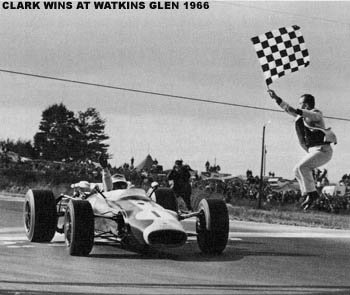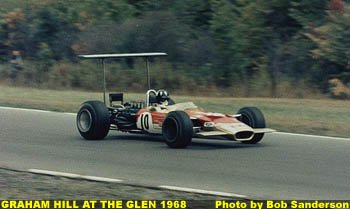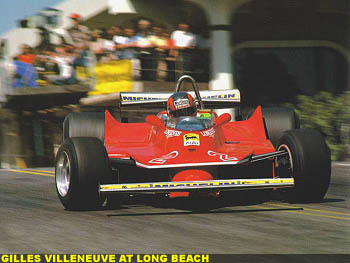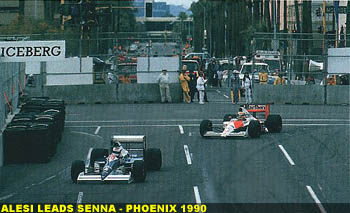|
The history of the United States Grand Prix begins 39 years ago at the Sebring track, in Florida. Even though the Indianapolis 500 counted for the Formula One World Championship in the '50s, it was never regarded as such - having different drivers, different cars and different engines - and therefore, the first official Grand Prix on American soil took place in 1959 at the sun and oranges state. It was the final race of the '59 season and saw Jack Brabham take his first World Championship while crossing the finish line on foot. On the final lap, on the uphill straight towards the finish, Brabham ran out of fuel in leading position. Brabham's Cooper teammate, Bruce McLaren, slowed down behind Brabham but the latter waved him by. McLaren took the win just in front of Maurice Trintignant, in another Cooper. Ferrari driver Tony Brooks came in third. While his points wouldn't matter for the championship (only the best five scores from nine races counted), Brabham took the flag in style, having pushed his car up the hill for about 400 meters.
 From 1961 until 1980, the remarkable Watkins Glen hosted the American Grand Prix. The first race brought Lotus' Innes Ireland his only victory, in a field almost exclusively powered by Climax engines. Dan Gurney, one of the two Porsche powered drivers, was the only one able to follow Ireland, finishing a mere four seconds behind the British Lotus pilot. The race concluded a season, which brought Formula One its first American World Champion, Phil Hill, but without celebration after his only rival and Ferrari teammate Wolfgang von Trips lost his life at Monza. From 1961 until 1980, the remarkable Watkins Glen hosted the American Grand Prix. The first race brought Lotus' Innes Ireland his only victory, in a field almost exclusively powered by Climax engines. Dan Gurney, one of the two Porsche powered drivers, was the only one able to follow Ireland, finishing a mere four seconds behind the British Lotus pilot. The race concluded a season, which brought Formula One its first American World Champion, Phil Hill, but without celebration after his only rival and Ferrari teammate Wolfgang von Trips lost his life at Monza.
From 1962 until 1967, just two drivers were capable of winning in the US: Jim Clark and Graham Hill each took home three victories, Clark for Lotus and Hill for BRM. Watkins Glen was a track where both gave their absolute best, most of the time the less dominant of the two in the championship taking the win in America.
1968 was the dawn of a new era in more than one way. Beside Jackie Stewart ending the 6 year winning streak of Clark and Hill, a real sensation was set in qualifying. A young American named Mario Andretti (Lotus) took pole in the first race in which he took part (Andretti was present the race before in Monza, but never drove). And even though his greatest rival, Matra driver Jackie Stewart, won the race, Graham Hill's second place was enough to give him and Lotus the World Title.
 In the years that followed, all winners were drivers scoring their very first win: Jochen Rindt for Lotus in 1969, then Emerson Fittipaldi for the same team and in 1971 Francois Cevert. In 1972 Jackie Stewart was back on top, in a one-two for Tyrrell. After a successful year, faith turned the opposite way in 1973. Jackie Stewart had planned to retire after Watkins Glen with another championship and 100 Grand Prix driven. Eventually he retired with 99 races, when Tyrrell pulled out after Stewart's teammate, Francois Cevert, was killed in practice on the track that brought him his only win. In the years that followed, all winners were drivers scoring their very first win: Jochen Rindt for Lotus in 1969, then Emerson Fittipaldi for the same team and in 1971 Francois Cevert. In 1972 Jackie Stewart was back on top, in a one-two for Tyrrell. After a successful year, faith turned the opposite way in 1973. Jackie Stewart had planned to retire after Watkins Glen with another championship and 100 Grand Prix driven. Eventually he retired with 99 races, when Tyrrell pulled out after Stewart's teammate, Francois Cevert, was killed in practice on the track that brought him his only win.
Tragedy struck The Glen for the second year in a row. In Lap ten of the race, Austrian Helmut Koinigg, in just his third Grand Prix, lost control of his Surtees in the very same corner that killed Cevert the year before. This tragic accident overshadowed the exciting battle for the championship between Emerson Fittipaldi (McLaren) and Clay Regazzoni (Ferrari), who entered the race sharing the championship lead. The race ended with a one-two for Brabham and with Fittipaldi champion, but without joy. During the race, the Brazilian's title was never in doubt, as Regazzoni had the worst race of the season, having huge tyre problems from start to finish.
In 1975 the inevitable happened: after 16 years, Ferrari scored its first win in the US, with new World Champion Niki Lauda taking victory. In the year that followed, the British promotor Chris Pook, managed to bring America a second Grand Prix. The US-West Grand Prix at Long Beach was designated to be the American Monaco. From 1976 until 1983 the Californian street track hosted the second home of Formula One in the land of Indycars. Meanwhile the original US Grand Prix at Watkins Glen was won by McLaren driver James Hunt twice in a row.
 1978 was a unique year again for Formula One in the US: one driver took both victories on American soil: Ferrari driver Carlos Reutemann fended off the strong Lotuses on both sides of the country. The Argentinean's feat was repeated by Ferrari driver Gilles Villeneuve in the following year. 1978 was a unique year again for Formula One in the US: one driver took both victories on American soil: Ferrari driver Carlos Reutemann fended off the strong Lotuses on both sides of the country. The Argentinean's feat was repeated by Ferrari driver Gilles Villeneuve in the following year.
In 1981 the US Grand Prix left its home and moved from Watkins Glen to Las Vegas. With both races in the west of the US now, the Las Vegas race was aptly named Caesar's Palace Grand Prix, after the casino where the track was situated. It was a dreadful event, in which commercial motives overshadowed the sportive aspect of Formula One. In 1982 the Las Vegas monster returned for a second and final time, alongside Long Beach and the newly added street track in Detroit, giving America as much as three races, something that did not happen again to this day.
The US races became more or less the John Watson show, with first a win in Detroit from 17th on the grid and then a second place in Las Vegas with Watson ending up just short of the title because he needed a win to beat Keke Rosberg.
The next year, the Watson show continued. Watson won the race after starting from 22nd on the grid in Long Beach. That was the biggest comeback from the starting grid ever seen in Formula One. It was also the final race in Long Beach. Another temporary street circuit was added, this time in Dallas. In one of the hottest Grands Prix of all time, Keke Rosberg kept his head cool, literally. With a water cooled cap under his helmet, he was able to withstand the heat and brought Williams victory. But the race was a complete disaster - with just eight drivers reaching the finish line, of which Nigel Mansell did a brave attempt to repeat Jack Brabham's "push the car over the finish line" act of 25 years before. Mansell reached the finish line and then collapsed, scoring one well deserved point.
 After the Dallas disaster, only Detroit remained on the Formula One calendar. For four more years, Motor City hosted a race, with Senna winning three times in a row from 1986 until 1988, the first two for Lotus and the third for McLaren. When the circus moved from downtown Detroit to downtown Phoenix, Ayrton Senna wasn't bothered. Even though Prost won in 1989, with Senna having an electric failure, Ayrton was back in 1990 and 1991, to win the final two races held in the US. With a total number of wins at five, America is, together with Monaco, the country in which Senna was most successful. After the Dallas disaster, only Detroit remained on the Formula One calendar. For four more years, Motor City hosted a race, with Senna winning three times in a row from 1986 until 1988, the first two for Lotus and the third for McLaren. When the circus moved from downtown Detroit to downtown Phoenix, Ayrton Senna wasn't bothered. Even though Prost won in 1989, with Senna having an electric failure, Ayrton was back in 1990 and 1991, to win the final two races held in the US. With a total number of wins at five, America is, together with Monaco, the country in which Senna was most successful.
However, in 1990 a young Frenchman amazed the world by fiercely battling the great Senna in his Tyrrell: Jean Alesi did what nobody else could, only just failing in the end. And in the final race, another young driver started to shine his star; Mika Hakkinen made his Formula One debut in the streets of Arizona, driving the terrible Lotus-Judd to a 13th spot on the grid. Of the currently active Formula One drivers, Hakkinen, Alesi and Johnny Herbert are the only ones to ever drive a US Grand Prix.
|

